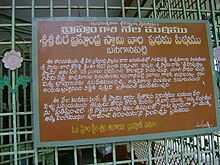Banganapalle
| Banganapalle బనగానపల్లె | |
|---|---|
| town | |
 | |
 Banganapalle | |
| Coordinates: 15°19′00″N 78°14′00″E / 15.3167°N 78.2333°ECoordinates: 15°19′00″N 78°14′00″E / 15.3167°N 78.2333°E | |
| Country |
|
| State | Andhra Pradesh |
| District | Kurnool |
| Elevation | 209 m (686 ft) |
| Languages | |
| • Official | Telugu |
| Time zone | IST (UTC+5:30) |
| Vehicle registration | AP 21 |
Banganapalle (also Banagana Palli; Telugu: బనగానపల్లె) is a town in the state of Andhra Pradesh, India. It lies in Kurnool district, 70 km south of the town of Kurnool. Banganapalle is famous for its mangoes, commonly called 'Banginapalli variety' and even has a cultivar, Banganapalli, named after it. Between 1790 and 1948, Banganapalle was the capital of a princely state of the same name.And also this mandal contains lot of stone mines, which are located in ramapuram, one of largest black stone production area in India(industrial area of black stones).
Geography
Banganapalle is located at 15°19′00″N 78°14′00″E / 15.3167°N 78.2333°E.[1] It has an average elevation of 209 metres (688 ft).
Princely history

In 1601, Sultan Ismail Adil Shah of Bijapur conquered the fortress of Banganapalle from Raja Nanda Chakravathy. The fort and surrounding districts were placed under the control of his victorious general, Siddhu Sumbal, who held them until 1665. Muhammad Beg Khan-e Rosebahani was granted Bangangapalle and the surrounding jagir in perpetual fiefdom but died without a male heir, leaving the jagir of Banganapalle to his grandson and adopted son, Faiz Ali Khan Bahadur. The Mughal emperor Aurangzeb conquered the Sultanate of Bijapur in 1686, but Faiz Ali Khan's fief was secured by the intervention of his maternal uncle Mubariz Khan, who served as Aurangzeb's viceroy of the Deccan.
Banganapalle mangoes
Banganapalli is a mango cultivar named after Banganapalle. An unspoilt obliquely oval specimen presents an unblemished golden yellow thin edible skin. This increasingly popular cultivar of mango also goes by the names of 'Baneshan' in Hindi and is also spelt 'Baiganpalli' or 'Beganpalli'. These mangoes are large sized, weighing on an average 350-400 grams. The pulp is fibreless, firm and yellow with sweet taste and the mangoes are very very famous in banganapalle [2] This variety is the most sought after from Andhra Pradesh.[3]
Banks
- State Bank of India
- Andhra Bank
- Syndicate Bank
- Andhra Pragathi Grameena Bank
- KDCC Bank
Places of tourist interest
Just 25 km away,there is a 2nd largest cave in India. The name of cave is Belum Cave.
- Yaganti - Hindu piligrimage place
- Veerabramhendra Swami Matham
- Mahanandi
- Belum Guhalu or Belum Caves
Brahmam gari matham (Veerappaiah temple & Chintamanu matham)

Veerabrahmendra Swamy, an Incarnation of Lord Vishnu, Authored kalagnana, a rare of its kind, which foresees the future, past and present. Sree Veerabrahmendra Swamy, was called as Veerambhotlayya during his childhood. Swamy at the age of 11, after the demise of his father Yanamadala. Veerabhojayacharya gave Mantropadesam to his mother and continued his spiritual journey from Pappagni Mutt, Chikballapur and arrived at Banganapalle, stayed in Garimireddy Achhamma house. Garimireddy Venkatareddy and Achhamma Couple are natives of Bhanumukkala Village, Banganapalle. Swamy, identified himself as Veerappaiah to Garimireddy Couple. At the first instance itself, Garimireddy couple noticed a divine glow in Swamy. Veerabrahmendra Swamy, requested to be as a Gopalaka (cows caretaker) at their home. Every morning, Swamy used to take the cows to Ravvalakonda. It is said that Swamy, used to draw a line around and the cows used to maze the grass inside the drawn circle. Cruel animals like tiger and lion could not cross the line. Swamy, used to sit in the Ravvalakonda Caves and written Kaalagnana on the talapatras. From the other cowherds, Achhama heard about Swamy's Devine activities and she herself went in to the caves and seen Swamy varu sitting on a mahasarpa and writing the Kaalagnana. Achhamma understood that Brahmam garu is the almighty god and she became the disciple of Swamy.
- Veerabrahmendra Swamy as Veerappaiah stayed for a period of 25 years in Banaganapalle.
- Swamy showed many miracles during his stay at banaganapalle.
- Banaganapple Nawab, Meer Fazal Ali Khan Bahaddur, in order to test Swamyji, bought a pregnant horse in to the courtyard and asked Swamyji to prophesize the gender of the baby in the horse womb. To everyone's surprise, Swamy said the gender of the baby horse. After this the Nawab had lot of faith in Swamyji's pronouncements.
- Swamy gave eyes with his mystic powers to Brahmananda reddy, son of Garimireddy Achamma, Venkatareddy.
- Swamy has lit all the lamps with water at Banganapalle nawab samsthan.
- Sri. Garimireddy Venkatareddy, Achhamma couple constructed the nelamutt. Veerappaiah temple in the year 1622. Annajaiah, from kasi was in search of a guru, and he is destined to come to Banaganapalle and became the discipline of Veerabrahmendra Swamy. Banaganapalle Nawab, disciple of Brahmam Garu, has donated 50 acres (200,000 m2) of land for the Veerappaih temple.
- Veerabrahmendra Swamy has written totally 4,32,000 tala patras Kaalagnana. Swamy Kaalagnanam is kept in a patara (wooden closet) and chintachettu (Tamarind tree) is planted on top of it.
- Annajaiah, disciple of Veerabrahmendra Swamy was appointed as head of the Mutt at Banaganapalle.


-

Chintamanu matham - The place where Sree Veerabrahmendra Swamy Kalagnanam is kept in a wooden closet and a chintamanu is planted.
-

Veerabrahmendra swamy Nelamatham - Banaganapalle
-

Sree vinayaka at Veerabrahmendra swamy Nelamatham - Banaganapalle
-

Sree veerappayya at Veerabrahmendra swamy Nelamatham - Banaganapalle
-

Sree veerappayya Garbhagudi at Veerabrahmendra swamy Nelamatham - Banaganapalle
-

Sree veerappayya Garbhagudi at Veerabrahmendra swamy Nelamatham - Banaganapalle
See also
References
http://www.kalagnani.com (Sri Veera Brahmendra Swami Matam, kandimallayapalle)http://www.kalagnani.org (Sri Veera Brahmendra Swami Matam, kandimallayapalle)
External links
| Wikisource has the text of the 1911 Encyclopædia Britannica article Banganapalle. |
| ||||||||||||||